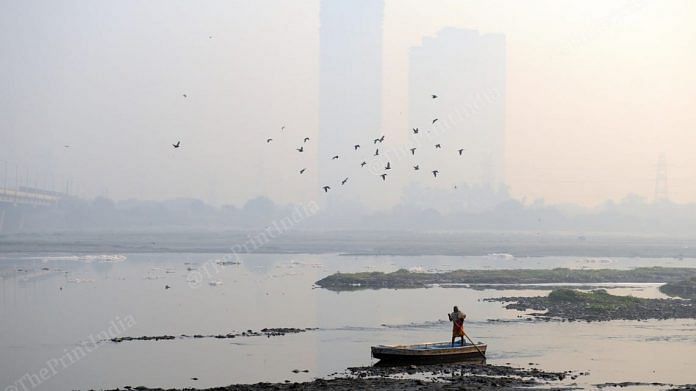
New Delhi: Stubble burning in Haryana and Punjab, which causes toxic smog to hang over vast swathes of land over North India, hit its peak last weekend, but is expected to decline this week.
Delhi is, however, unlikely to get any relief from toxic air in the coming days as several meteorological conditions in the national capital are causing air pollutants to accumulate.
Ravindra Khaiwal, a researcher at PGIMER in Chandigarh, said the incidents of crop burning this year saw a 20 per cent increase since the previous year.
“Compared to 2018, 2019 saw a dip in the number of stubble burning incidents. However, we were not able to sustain the progress this year,” Khaiwal told ThePrint.
Between September and October every year, farmers in Punjab and Haryana harvest their paddy crops. The harvest leaves behind stalks of standing rice crop, which have to be cleared before the winter sowing season.
In order to quickly get rid of this stubble, farmers set them on fire. Smoke rising from these fires make their way down the Indo-Gangetic plain, engulfing several states in thick smoke.
Cities in North-Indian states such as Kanpur, Faridabad, Gurugram, Bhiwadi — which are already polluted through the year — bear the worst brunt of the smoke from paddy fields. The drop in temperature also worsens the air quality as the pollutants are unable to disperse easily when the air is cold.
‘Need to focus on city emissions’
Khaiwal’s team at the PGIMER tracked the stubble fire count this year, and compared it to the average fire counts between 2012 and 2019.
“We need to focus on city emissions and be better prepared for sustainable uses of stubble next year,” Khaiwal wrote in a tweet Tuesday, sharing the graph.
The peak of crop residue burning is going down as predicted. We need to focus on city emissions & better prepared for sustainable uses of stubble next year. @PIB_India @SumanMor_PU @PunjabGovtIndia @ROBChandigarh @CPCB_OFFICIAL @cmohry https://t.co/IZHBFzgDj5 pic.twitter.com/yziWfQfMlH
— Ravindra Khaiwal (@RavindraKhaiwal) November 10, 2020
The graph indicates that policy measures introduced to discourage stubble burning in the two states were not implemented on the ground.
Delhi’s AQI Tuesday, according to the Central Pollution Control Board (CPCB), was 486 (severe category).
The maximum readings on CPCB pollution monitors is 500, and the monitors hit the maximum readings in many areas in Delhi, including ITO and Anand Vihar.
This means the AQI figure published by the CPCB will not read more than 500, since the value is an average of readings from all monitors.
According to the System of Air Quality and Weather Forecasting and Research (SAFAR), which functions under the Ministry of Earth Sciences, stubble fire counts in Punjab, Haryana, Uttar Pradesh, Uttarakhand and neighbouring areas marginally reduced Tuesday, but are still significantly high.
As many as 2,247 incidents of stubble burning were observed through satellite data Monday and the share of this smoke in Delhi’s air is estimated to be at 22 per cent Tuesday.
Weather conditions unfavourable for Delhi
SAFAR’s analysis painted a grim picture for Delhi’s already worsening air quality.
It suggested that an increase in humidity in Delhi and extremely calm local surface winds were causing air pollutants to accumulate. Winds were also transporting the smoke from the stubble fires.
The analysis also showed while the winds may reverse, no quick recovery in Delhi’s AQI is expected.
Khaiwal pointed out that even though incidents of stubble burning are now declining, thousands of fires are still expected this week, before the stubble burning season comes to an end around this weekend.
Subscribe to our channels on YouTube & Telegram
Why news media is in crisis & How you can fix it
India needs free, fair, non-hyphenated and questioning journalism even more as it faces multiple crises.
But the news media is in a crisis of its own. There have been brutal layoffs and pay-cuts. The best of journalism is shrinking, yielding to crude prime-time spectacle.
ThePrint has the finest young reporters, columnists and editors working for it. Sustaining journalism of this quality needs smart and thinking people like you to pay for it. Whether you live in India or overseas, you can do it here.